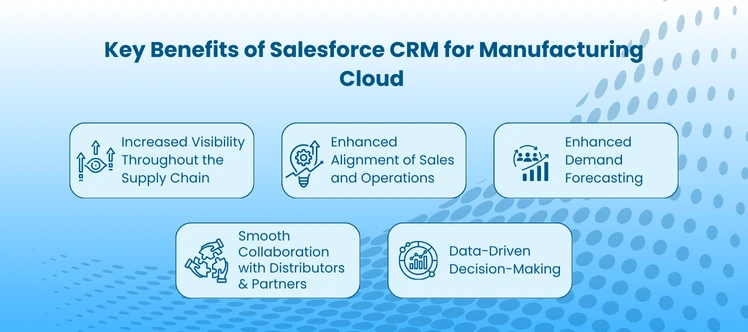A Comprehensive Guide to 2025’s Salesforce Manufacturing Cloud
Businesses are targeting improved customer experiences, streamlined processes, and efficient supply chains as the manufacturing sector undergoes a digital transition. Salesforce Manufacturing Cloud is intended to assist manufacturers in automating procedures, gaining real-time visibility, and making data-driven decisions for sustained success.
Salesforce Manufacturing Cloud: What is it?
By combining sales contracts, production data, inventory levels, and customer contacts onto a single platform, Salesforce Manufacturing Cloud offers a unified perspective of corporate operations. Manufacturers can use it to forecast demand, maximize resources, and improve cooperation with distributors and suppliers.
Salesforce Manufacturing Cloud’s Principal Advantages
Increased Supply Chain Visibility: Learn about demand, inventories, and manufacturing schedules in real time.
Improved Alignment of Sales and Operations: Sales agreements enable real-time monitoring of pricing and client commitments.
Improved Demand Forecasting: By accurately predicting market demand, AI-powered analytics can cut down on overproduction and stockouts.
Improved Cooperation: with Partners For smooth collaboration, share real-time data with distributors and suppliers.
Data-Driven Decision-Making: Analytics and machine learning offer practical insights for cutting expenses and increasing profits.
Salesforce Manufacturing Cloud’s salient features
Sales Agreements – Streamline contract tracking for accurate sales and production planning.
Account-Based Forecasting – Customize demand forecasting for specific customers.
Advanced Analytics & Reporting – Track sales performance, demand trends, and operational efficiency.
Seamless ERP Integration – Connect with ERP and MES systems for smooth data flow and better process management.
Best Practices for Implementation
Define Clear Goals – Set objectives and align them with business needs.
Engage Stakeholders Early – Involve key departments like sales, operations, and IT.
Provide Employee Training – Ensure teams understand and utilize all features.
Start with a Pilot Project – Test on a smaller scale before full implementation.
Monitor and Optimize – Continuously refine processes and integrate feedback.
Overcoming Implementation Challenges
Resistance to Change – Invest in training and change management strategies.
Data Migration Issues – Work with Salesforce experts for smooth data transition.
Customization & Scalability – Regularly update and adapt the platform for evolving business needs.
Maximizing ROI with Salesforce Manufacturing Cloud
Reduce manual labor and increase productivity by automating and streamlining processes.
Connect with Additional Salesforce Products For a cohesive customer experience, integrate Einstein AI, Sales Cloud, and Service Cloud.
Make Use of AI and New Technologies Make proactive decisions by utilizing AI-driven insights.
In conclusion
One effective technology that helps factories increase productivity, foster better teamwork, and spur expansion is Salesforce Manufacturing Cloud. Manufacturers may maintain their competitive edge in a world that is becoming more digital by utilizing their strengths. AnavClouds Software Solutions may assist you in expediting the Salesforce Manufacturing Cloud implementation process if you’re prepared to do so. Make an appointment for a consultation right now!


